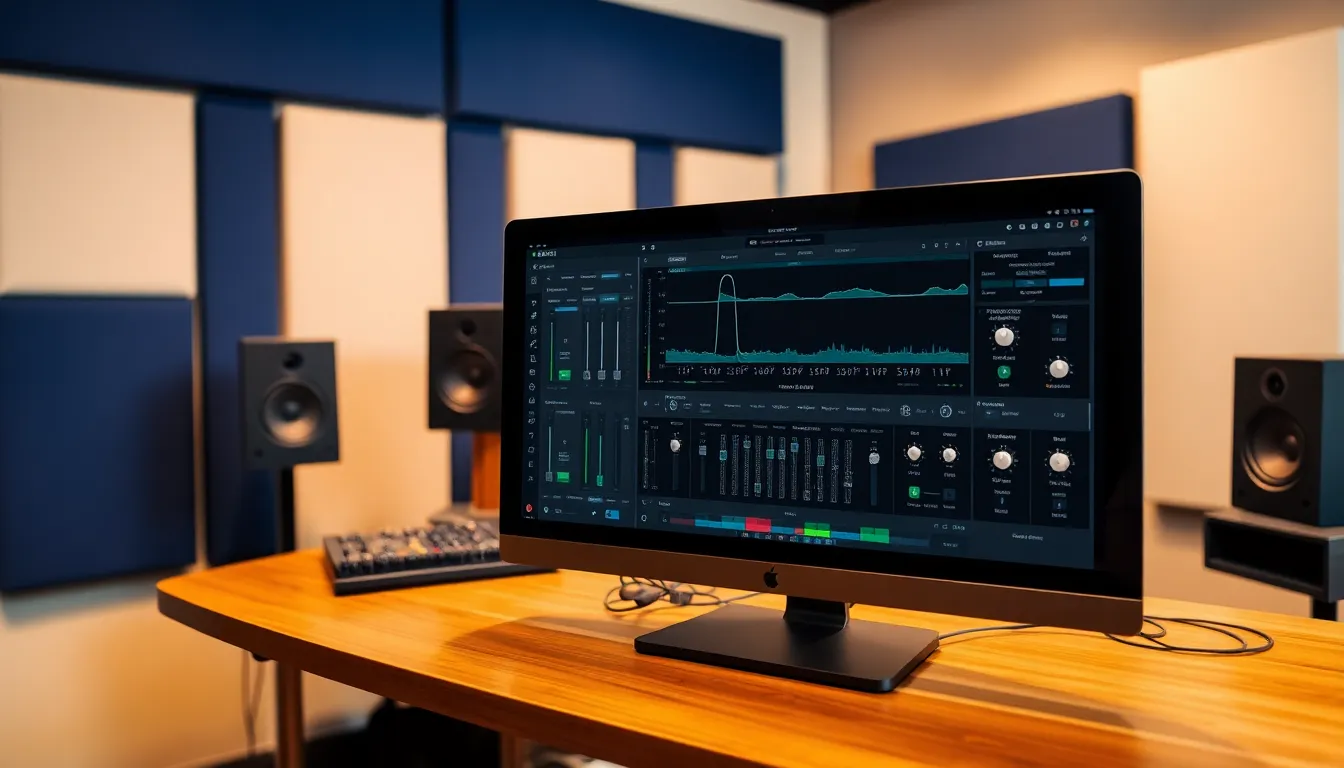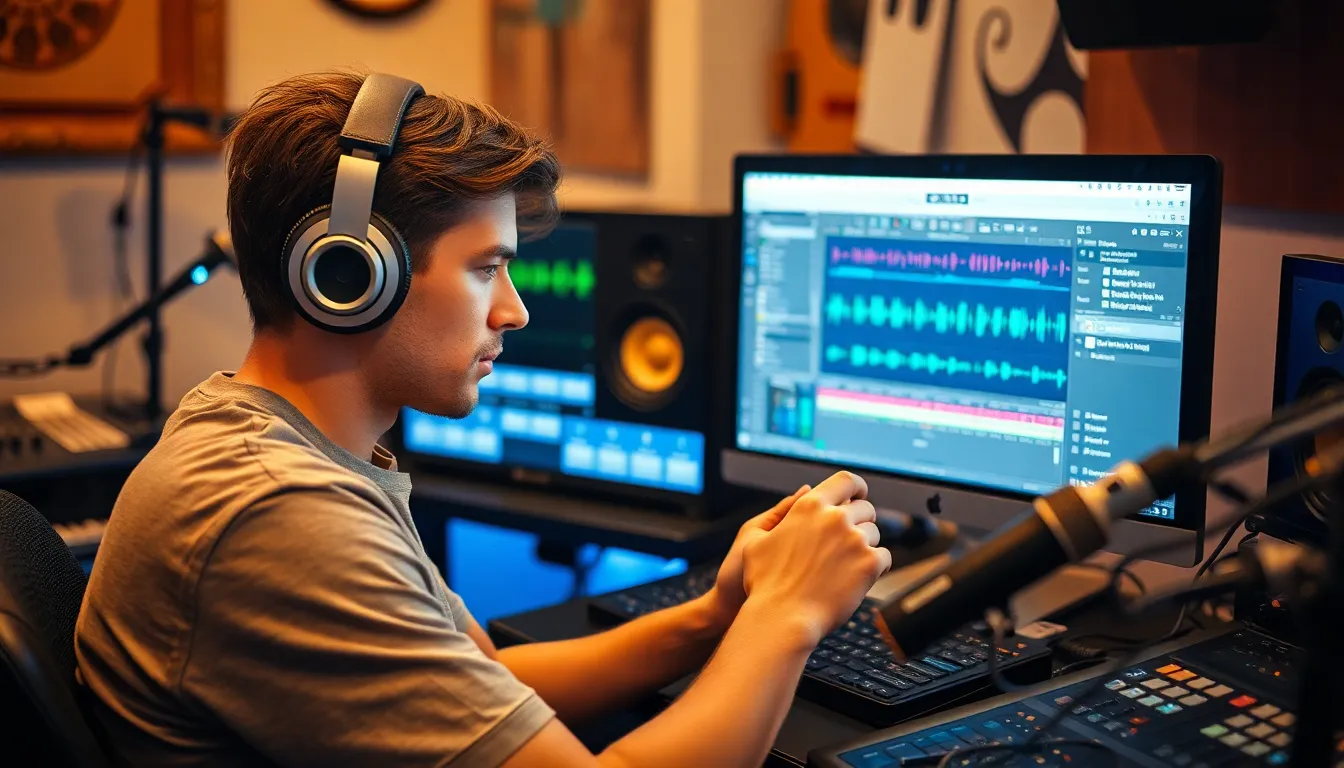In a world where silence is golden, audio effects are the shiny jewels that make sound truly sparkle. Whether it’s transforming a simple voice into a booming echo or adding a sprinkle of reverb to a guitar riff, these effects can turn an ordinary audio experience into an unforgettable one. Imagine your favorite song without that catchy delay or your podcast without the crisp clarity of compression—yawn, right?
Table of Contents
ToggleOverview of Audio Effects
Audio effects play a crucial role in sound production by enhancing the overall quality of audio. Reverb simulates the natural reflections of sound in spaces, creating depth and space. Echo can add a rhythmic element, allowing sounds to bounce back, enriching a track’s texture.
Chorus thickens audio by duplicating and slightly altering the pitch of a signal, giving it a fuller sound. Distortion alters the signal’s waveform, often resulting in a gritty or warm quality that adds character. Compression reduces the dynamic range, making quiet sounds louder while taming peaks for a more balanced listening experience.
Equalization adjusts frequency levels, allowing for precise tuning of sounds to better fit within a mix. Delays create a time-based effect, causing sound to repeat at specified intervals, enhancing complexity. Flanging produces a sweeping effect through phase shifting, generating a unique, vibrant sound.
Stereo widening expands the soundstage, allowing audio to feel more immersive. Modulation effects, like tremolo and vibrato, add movement and dynamism, enriching the listening experience. Filtering can remove unwanted frequencies, emphasizing the desirable components of sound.
Utilizing these audio effects, producers can create unique sounds that capture listeners’ attention. Each effect serves a distinct purpose, contributing to the overall impact of music or audio productions. Without the strategic application of these techniques, audio would lack its engaging and expressive qualities.
Types of Audio Effects

Audio effects play a critical role in shaping sound. They enhance audio and contribute significantly to the listening experience.
Time-Based Effects
Time-based effects manipulate sound over a specific duration. Delay creates a gap between the original sound and its repetitions. Echo, a type of delay, repeats sound at intervals, adding depth. Reverb simulates reflections in a physical space, enriching sound timbre. Flanging achieves a sweeping effect by mixing delayed signals, producing a unique auditory experience. These effects create a sense of space, making audio more immersive and engaging.
Dynamic Effects
Dynamic effects control the volume and intensity of sound signals. Compression smooths out audio levels, balancing louder and softer sounds. Limiting prevents audio clipping by capping peak levels. Expansion enhances quieter passages, adding detail. Gates eliminate unwanted noise by cutting out sound below a set threshold. These effects ensure clarity and consistency in playback, ultimately enhancing overall audio quality.
Frequency-Based Effects
Frequency-based effects adjust the tonal balance of audio. Equalization modifies specific frequency ranges, allowing for fine-tuning of sound. This process helps highlight or reduce certain tonal qualities in recordings. Filters can remove unwanted frequencies entirely, shaping the overall sound character. High-pass and low-pass filters allow only certain frequencies to pass through, emphasizing desired sounds. These effects refine audio quality, leading to a polished listening experience.
How Audio Effects Work
Audio effects transform sound through various techniques, enhancing audio quality and overall listener experience.
Signal Processing Techniques
Signal processing techniques play a crucial role in audio effects. They manipulate sound waves to achieve desired sonic textures. Digital signal processing (DSP) alters audio signals using mathematical algorithms, enabling precise control of effects like reverb and delay. Compression reduces dynamic range, ensuring quieter sounds become audible. Equalization adjusts frequency response, tailoring audio for clarity and richness. Filters shape tones by boosting or cutting specific frequencies. Each technique contributes to creating immersive audio that captivates listeners.
Digital vs. Analog Effects
Digital and analog effects serve unique purposes in audio production. Digital effects provide flexibility and precision through software plugins. They allow for easy adjustments and versatile sound processing. Analog effects, however, deliver warmth and character, often preferred in traditional recording settings. Tape saturation and analog distortion impart a subtle, musical quality. While digital effects are reliable for complex workflows, analog effects bring an organic feel. Each type offers distinct advantages, influencing the final sonic outcome in audio projects.
Application of Audio Effects
Audio effects play a crucial role in various fields, enhancing the listening experience and improving overall sound quality. Their application spans music production, film, and multimedia, showcasing their versatility.
In Music Production
In music production, audio effects shape the final sound, making it more dynamic and polished. Producers often use reverb to create spatial depth, allowing listeners to feel the atmosphere of a song. Vocals may benefit from compression to ensure consistency in volume, while equalization fine-tunes frequencies for clarity. Delay adds interesting rhythmic elements, enriching harmonies. Distortion can give instruments a powerful edge, making them stand out. These effects, when used strategically, enhance emotional impact, captivating audiences and elevating the overall listening experience.
In Film and Multimedia
Film and multimedia use audio effects to immerse viewers in storytelling. Sound design often incorporates reverb to replicate various environments, enhancing realism. Dialogue clarity is achieved through equalization and compression, ensuring that every word is intelligible. Sound effects rely on delay and echo to create a sense of space and movement. Moreover, specific effects like Foley add lifelike sounds that complement visuals, creating an engaging experience. Ultimately, these audio effects contribute significantly to a film’s emotional resonance, shaping how audiences connect with the narrative.
Audio effects play a vital role in shaping sound experiences across various media. Their ability to enhance audio quality not only captivates listeners but also elevates the overall emotional impact of music and film. By understanding and effectively applying different types of effects, producers can create richer and more immersive soundscapes.
The strategic use of time-based, dynamic, and frequency-based effects allows for a nuanced approach to sound design. This versatility ensures that every audio project can resonate with its audience in unique ways. As technology continues to evolve, the possibilities for innovative audio effects will only expand, making it an exciting time for sound creators.




